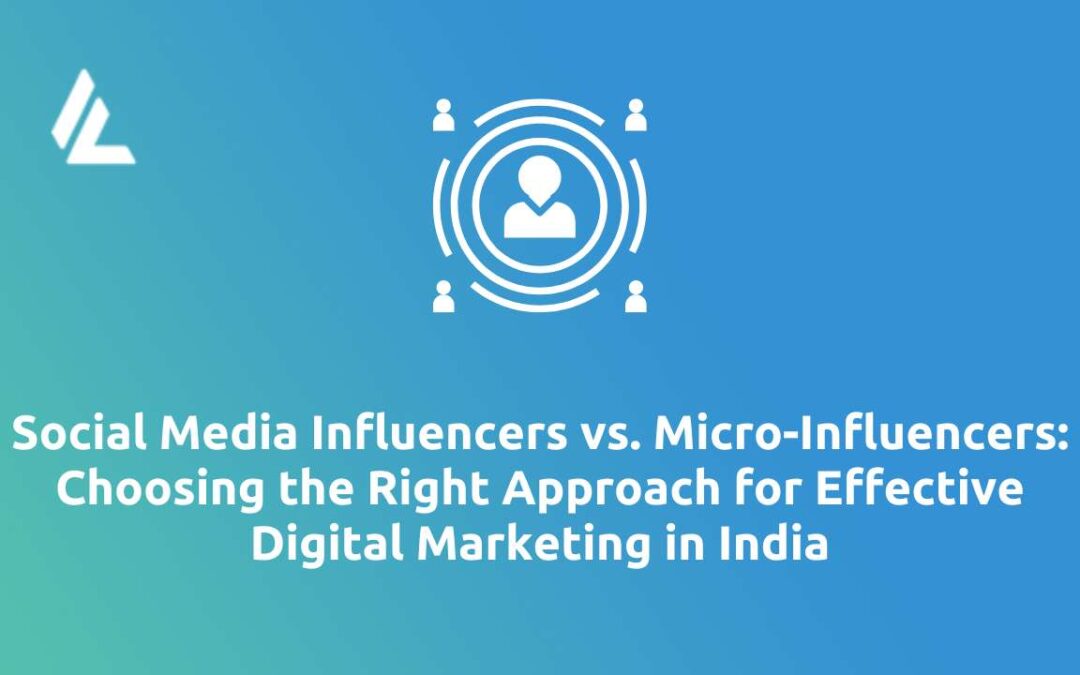Table of Contents
In recent years, digital marketing in India has witnessed a significant shift towards influencer marketing. Businesses are increasingly leveraging the power of influencers to promote their products and services on social media platforms. However, a crucial decision marketers face is choosing between social media influencers and micro-influencers. This blog explores the key differences between the two and helps you understand which approach is more suitable for your digital marketing strategy in India.
1. Understanding Social Media Influencers
Social media influencers are individuals who have amassed a substantial following on platforms like Instagram, YouTube, or TikTok. They typically have a large fan base and possess the ability to influence their audience’s purchasing decisions. These influencers are often celebrities, industry experts, or famous personalities known for their expertise or talent.
The keyword “digital marketing in India” is essential for brands seeking wide exposure in the Indian market. By collaborating with social media influencers who have a massive following, businesses can tap into a vast audience base, increasing their brand visibility and reach across the country. Social media influencers have the potential to create a significant impact and help brands gain recognition in the Indian digital landscape.
2. Exploring Micro-Influencers
Micro-influencers, on the other hand, have a smaller but highly engaged and niche audience. These individuals usually focus on a specific industry or interest and have a more intimate connection with their followers. They are often considered more relatable and authentic as they have built their following based on their expertise or passion.
When it comes to digital marketing in India, micro-influencers play a vital role in targeting specific audience segments. By partnering with micro-influencers who have a deep understanding of their niche, brands can engage with a highly interested and loyal audience, leading to higher conversion rates. Micro-influencers provide an opportunity to deliver more targeted messages and offerings to a specific subset of the Indian market, allowing brands to connect with their ideal customers more effectively.

3. Reach vs. Engagement: The Battle of Numbers
One of the primary considerations when choosing between social media influencers and micro-influencers is the reach versus engagement aspect. Social media influencers have a wider reach due to their extensive follower base. They can help businesses generate brand awareness on a larger scale. However, with this broader reach comes a diluted level of engagement, as their followers may not be as connected or interested in every sponsored post.
On the other hand, micro-influencers have a smaller reach but tend to have higher engagement rates. Their followers are often more loyal and actively interested in the niche or industry they represent. By collaborating with micro-influencers, brands can generate more meaningful interactions and build long-term relationships with their target audience in the Indian digital market. Micro-influencers have the potential to create a stronger impact and foster deeper connections with their audience, leading to higher levels of engagement and conversion.
4. Authenticity and Credibility
Authenticity and credibility are crucial factors for successful influencer marketing campaigns in India. Social media influencers, especially celebrities or well-known personalities, may face challenges in maintaining their authenticity due to the sheer number of brand collaborations they undertake. As a result, their audience might perceive their sponsored content as less genuine, leading to lower trust and engagement.
Micro-influencers, on the other hand, are often perceived as more authentic and relatable. They have a stronger personal connection with their followers and tend to be highly selective with their brand partnerships. This authenticity fosters trust among their audience, making micro-influencers effective advocates for digital marketing campaigns in India. Working with micro-influencers allows brands to tap into their credibility and authenticity, creating a stronger bond between the brand and the target audience.
5. Cost-Effectiveness
Another crucial consideration for businesses in India is the cost-effectiveness of influencer marketing. Social media influencers with larger followings often charge higher fees for collaborations. This can be a significant investment for brands, especially those with limited marketing budgets.
Micro-influencers, being less well-known, typically charge lower fees for collaborations. This makes them a more cost-effective option for brands looking to maximize their return on investment in digital marketing in India. By working with multiple micro-influencers instead of a single social media influencer, brands can reach a wider audience while keeping costs under control. The cost-effectiveness of micro-influencers allows brands to allocate their resources efficiently and explore multiple collaborations to amplify their brand message.
6. Niche Targeting and Conversion Rates
The Indian market is diverse and consists of various niche segments. Micro-influencers play a crucial role in targeting these specific audience segments. By partnering with micro-influencers who have a deep understanding of their niche, brands can deliver more targeted messages and offerings, leading to higher conversion rates.
On the other hand, social media influencers may have a more generalized appeal, making it challenging to cater to specific niche segments effectively. However, they can still provide valuable exposure and generate brand awareness among a broader audience, making them suitable for certain marketing objectives. Depending on the brand’s target audience and specific goals, a combination of both social media influencers and micro-influencers can be utilized to cover a wide range of demographics and interest areas, ensuring comprehensive niche targeting and maximizing conversion opportunities.

Conclusion
In the realm of digital marketing in India, both social media influencers and micro-influencers have their unique advantages and considerations. Choosing the right approach depends on the specific goals, target audience, and budget of the brand. Social media influencers offer wider reach and brand exposure, while micro-influencers provide higher engagement, authenticity, and cost-effectiveness.
To leverage the power of influencer marketing effectively in the Indian market, brands should carefully analyze their objectives, conduct thorough research, and align their strategies with the right influencers, whether they are popular social media influencers or niche-focused micro-influencers. By striking the right balance, brands can achieve impactful digital marketing campaigns, boost brand awareness, and drive meaningful conversions in India’s dynamic and diverse digital landscape.

